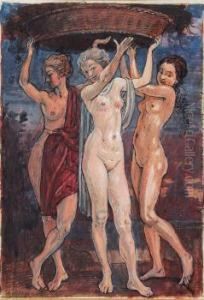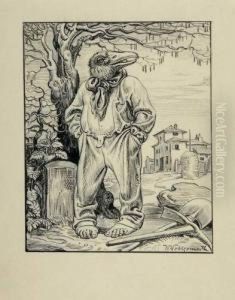Wilhelm Wohlgemuth Paintings
Wilhelm Wohlgemuth was a German artist known for his contributions to the field of printmaking, specifically woodcuts. He was born in 1884, in a time when Europe was teeming with new artistic movements and explorations. Although not as widely recognized as some of his contemporaries, Wohlgemuth made significant strides in his medium, carving out a niche for himself in the German art scene.
Wohlgemuth's early life and training are not extensively documented, but it is known that he engaged in the typical artistic education of the time, likely involving an apprenticeship or study under established artists. He would have been influenced by the prevailing art movements of the late 19th and early 20th centuries, such as Impressionism, Expressionism, and the Secessionist movements that were particularly strong in Germany and Austria.
During his career, Wohlgemuth's work would have been shaped by the historical events of his time, including the two World Wars and the tumultuous interwar period. These events had a profound impact on the artistic expression of many European artists, and woodcut art, with its stark contrasts and capacity for expressive, bold imagery, was particularly suited to reflecting the societal upheavals of the time.
Wohlgemuth's artistry in woodcut printmaking would have involved the careful carving of an image into a wood block, which was then inked and pressed onto paper to create a print. This technique allowed for the production of multiple copies of a single design and was commonly used for illustrations in books and periodicals, as well as for creating standalone artworks. Wohlgemuth would have been a part of a tradition that included great names like Albrecht Dürer, and he would have contributed to the modern revival of the woodcut technique that gained popularity as part of the Expressionist movement.
Unfortunately, little information is readily available about Wohlgemuth's personal life, exhibitions, and specific works. This lack of documentation can sometimes be the case with artists who, despite their talents, may not have achieved the same level of fame as their peers or whose works have not been as prominently preserved or studied.
Wilhelm Wohlgemuth passed away in 1967, leaving behind a legacy that, while perhaps not as celebrated as that of other artists from his era, remains part of the rich tapestry of German printmaking. His contributions to the woodcut medium, especially during a period of such intense creativity and experimentation in the arts, ensure that he holds a place in the history of 20th-century art.


